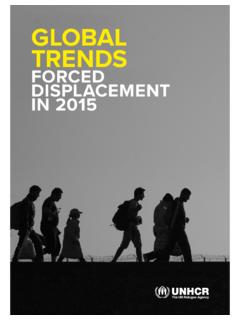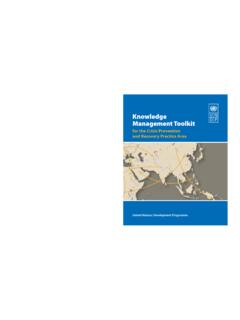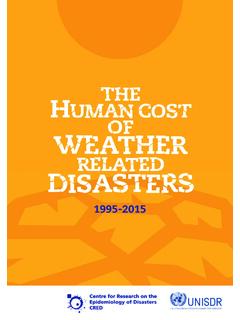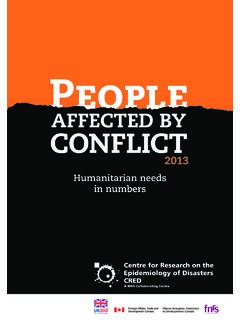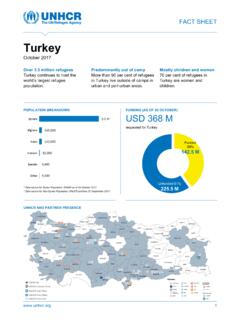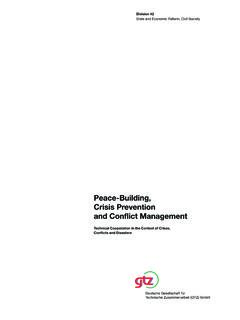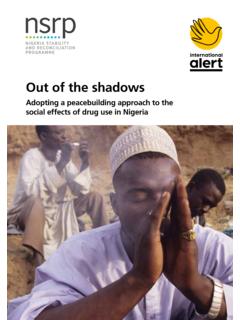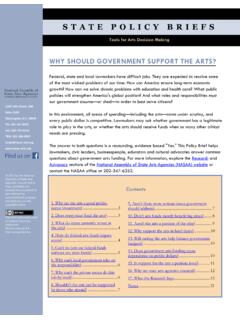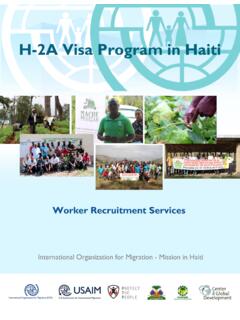Transcription of Working with Community Based Child Protection …
1 CPWG Sudan Working with Community - Based Child Protection Committees and Networks Handbook for facilitators 2012 Acknowledgements This handbook was developed under the guidance of the Child Protection Working Group in Sudan Organizations participating in the Working group include UNICEF, War Child Holland, Terres des Hommes, Save the Children Sweden and Word Vision International. Special thanks goes to all the members of the Child Protection Working Group for their invaluable contributions and inputs throughout the process of developing the handbook and in particular to UNICEF and War Child Holland, as Leader and Deputy Lead of the Child Protection Sub Sector for initiating and guiding the overall process. The CPWG contracted Child Frontiers Ltd. to undertake the development and finalisation of this handbook.
2 This handbook was developed by Padraig Quigley and Stephanie Delaney on behalf of the CPWG Sudan. The opinions reflected in this document, however, do not necessarily reflect those of the CPWG and its members. Child Frontiers Ltd. (Registered company No. 1275515) Suite A 15/F Hillier Commercial Building 65-67 Bonham Strand East Sheung Wan Hong Kong Handbook for Working with CBCPC/Ns I CPWG Sudan i Foreword The capacity of families and communities to care for and protect their most vulnerable members is often undermined in complex humanitarian situations. These risks are compounded where formal social welfare systems lack the reach to deliver services in areas of greatest need. In order to sustain children s Protection from violence, exploitation and abuse, humanitarian actors have promoted the establishment of Community - Based Child Protection Committees and Networks (CBCPNs).
3 A CBCPN normally serves as a forum where Community members meet, discuss Child Protection problems and research solutions. It is thus an informal Community structure, representing all sectors in the Community who have a role to play in protecting children including children themselves. While bringing concrete solutions to the situation of individual children and young people, they also serve as platforms for holding duty-bearers accountable for promoting Child rights and protecting children from violence. The Child Protection Subsector in Sudan has mapped more than one-hundred Networks. These have been established in response to specific humanitarian situations, mainly in the Darfur region, South Kordofan, Blue Nile and Abyei, but also in Khartoum and elsewhere. Where Subsector partners access to conflict affected areas has been an increasing challenge, CCPC/Ns have become a vital means of assuring the delivery of services; of conducting awareness-raising sessions amongst Community members; and of contributing to Child Protection rapid assessments and Protection monitoring.
4 Consequently, Subsector partners have invested considerable resources in supporting these networks through training and in-kind support. However, the level of assistance has been inconsistent, and has not been guided by a shared understanding of the role, functions and limitations of CBCPNs in emergencies. The Subsector has mandated a Working group comprised of Plan International, Save the Children Sweden, Terre des Hommes, UNICEF, War Child Holland, and World Vision International to produce a common Child Protection Handbook for Community Based CP Networks. The handbook is designed to assist programme and field staff in the establishment, capacity building and support of CBCNs with their work protecting children. Funding for this Handbook was provided by donors to the Common Humanitarian Fund in Sudan, through UNICEF. Handbook for Working with CBCPC/Ns I CPWG Sudan ii Content Foreword.
5 I Acronyms .. vi INTRODUCTION .. 1 Format and how to use the handbook .. 1 1. INTRODUCTION TO Child Protection .. 3 Overview .. 3 Technical notes .. 3 The protective environment .. 5 Eight elements of the protective environment for children .. 6 Actors responsible for Child Protection .. 7 Child Protection at the Community level .. 10 Principles and values of Child Protection work .. 10 Code of conduct .. 12 Child Protection in emergencies and humanitarian settings .. 13 Types of Protection children need most in emergencies .. 15 Protection responses in 15 Key messages .. 16 Resources .. 16 Activities .. 17 Activity 1: What is Child Protection ? .. 17 Activity 2: Child Protection concerns and their causes .. 19 Activity 3: Causes and consequences of Child Protection concerns .. 20 Activity 4: Code of conduct .. 23 Activity 5: Finding solutions to Child Protection concerns .. 25 2. Child DEVELOPMENT AND Child PARTICIPATION.
6 26 Overview .. 26 Technical notes .. 26 Dimensions of development .. 26 Developmental milestones and key stages .. 28 Influences on development .. 29 Importance of family and Community on development .. 29 Resilience and coping .. 30 Participation .. 31 Models of participation .. 32 Ways to enhance participation .. 34 Key messages .. 35 Resources .. 35 Activities .. 36 Activity 1: Understanding Child development Milestones and dimensions .. 36 Sheet 1 for Activity 1: Developmental milestones .. 38 Activity 2: Influences on Child development Experience from own childhood .. 43 Activity 3: Influences on Child development .. 44 Activity 4: Resilience and coping .. 45 3. CHILDREN S RIGHTS AND THE LEGAL SITUATION .. 46 Handbook for Working with CBCPC/Ns I CPWG Sudan iii Overview .. 46 Technical notes .. 46 Introduction to children s rights .. 46 International and regional children s rights agreements.
7 47 Monitoring the implementation of the international/regional laws and agreements .. 48 National legal and policy framework related to children s rights and Protection .. 49 Influence of Sharia and customary law .. 50 Definition of a Child .. 50 Key messages .. 52 Resources .. 52 Activities .. 53 Activity 1: Children s needs diamond .. 53 Activity 2: Rights of children .. 56 Activity 3: Children s rights Principles and values .. 58 4. ROLES AND RESPONSIBILITIES IN Community Based Child Protection .. 60 Overview .. 60 Technical notes .. 60 Main tasks, roles and responsibilities of CBCPC/Ns .. 61 Referral .. 65 Key messages .. 69 Resources .. 69 Activities .. 70 Activity 1: Who is involved in meeting the needs of children .. 70 Activity 2: What are CBCPC/Ns? .. 72 Activity 3: Role of different groups in addressing Child Protection concerns .. 73 Activity 4: Venn diagrams Links and gaps.
8 74 5. MOBILIZING COMMUNITIES TO PROTECT CHILDREN .. 76 Overview .. 76 Technical notes .. 76 What is a Community ? .. 76 Definition of Community mobilization .. 77 What does mobilizing communities for protecting children involve? .. 77 What makes Community - Based Child Protection groups effective? .. 78 Overview of Community mobilization .. 79 What are the characteristics and skills needed to be an effective Community mobilizer? .. 80 Tips on making first contact with the Community .. 81 Challenges to effective Community mobilization .. 82 Key messages .. 84 Resources .. 84 Activities .. 85 Activity 1: What is a Community ? .. 85 Activity 2: Effective Community mobilization .. 86 Activity 3: Qualities of Child Protection mobilizers and committees .. 87 Activity 4: Mobilization techniques .. 88 Activity 5: Group work stages of Community mobilization .. 89 6. COMMUNICATING with CHILDREN AND COMMUNITIES.
9 91 Handbook for Working with CBCPC/Ns I CPWG Sudan iv Overview .. 91 Technical notes .. 91 Verbal communication .. 92 Non-verbal communication .. 93 What influences communication and barriers to effective communication .. 94 Confidentiality .. 96 Listening skills .. 97 Techniques for showing active listening and encouraging communication .. 98 Empathy .. 98 Communicating with groups .. 98 Specific considerations when communicating with children .. 99 Additional barriers to communicating with children .. 100 Speaking with children about sensitive issues .. 100 Dos and don ts for communicating with children on sensitive issues .. 103 Key messages .. 104 Resources .. 104 Activities .. 105 Activity 1: Being a good communicator .. 105 Activity 2: Communication under the microscope .. 106 Activity 3: Communication pairs exercises .. 108 Activity 4: Communicating with children on sensitive issues.
10 110 7. ASSESSING THE SITUATION AND Protection NEEDS OF CHILDREN .. 111 Overview .. 111 Technical notes .. 112 What is a need assessment? .. 112 Principles influence the process of a need assessment for Child Protection .. 112 Information gathered during a need assessment .. 113 Participatory rural appraisal .. 114 Organizing a PRA .. 115 Overview of the need assessment or PRA process .. 116 Tools for the need assessment or PRA .. 116 Ten steps to conducting a PRA exercise .. 118 Organizing the need assessment through the PRA process .. 119 Challenges when conducting assessments using the PRA approach .. 121 Key messages .. 123 Resources .. 123 Activities .. 124 Activity 1: Problem ranking Pairs ranking method .. 124 Activity 2: Protection matrix .. 126 Activity 3: Social maps .. 128 Activity 4: Techniques for Community assessments .. 129 Activity 5: Planning a need assessment strategy.
